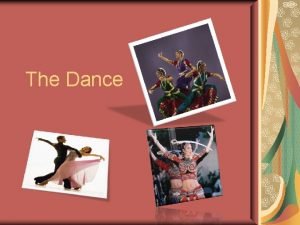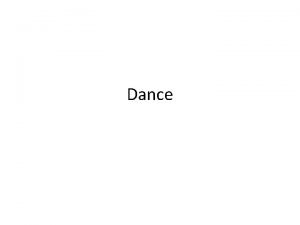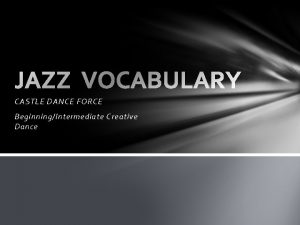A LEVEL DANCE A LEVEL DANCE Our new







- Slides: 7

A LEVEL DANCE

A LEVEL DANCE "Our new qualification offers your students the opportunity to place dance within a historical and cultural context, encouraging them to reflect upon their own practical work within the context of professional practice. It promotes the academic and transferable skills valued by Higher Education and employers. " Tracey Tickle, Chief Principal Examiner and Moderator for AS and A-level Dance

WHY PICK A LEVEL DANCE? • It’s a good combination to go with other written based exam courses • 50% is based on your practical ability • You get to work on your own and with other members of the class- is good for team building • It develops your confidence and leadership abilities • It develops your health and fitness and your general skills as a dancer • You get to experience lots of different dance styles and work with a range of music

"Dance is vital: an activity both exhilarating and liberating to watch or do. The instinct to dance is fundamentally joyous and no matter how hard you try, you can’t get away from it. It can also be a huge force for good, effectively drawing people together and levelling everyone through sheer hard work. All these things make dance such a challenging but exhilarating subject to take on at AS or A-level. I wish I’d had the chance to do that when I was young. " Richard Alston, Choreographer, Richard Alston Dance Company • The study of dance enables students to develop socially whilst promoting creativity, fitness and well-being. As your students become performers, they’ll also develop their confidence, self-esteem and team working skills. • Assessment includes a combination of practical dance tasks alongside creative extended writing assignments. This equips students with the necessary skills and experience to study dance further, or embark on an exciting career in the arts.

WHAT JOBS COULD IT LEAD TO? • Dancer • Choreographer • Theatre work- backstage/makeup/costume Set design/Lighting • Teaching- private/state schools • Workshop leader • Freelance dance work • Parties/kids clubs/Community work

WHAT DOES A LEVEL DANCE CONSIST OF? Component 2: Critical engagement Component 1: Performance and choreography • Solo performance linked to a specified practitioner within an area of study • Performance in a quartet • Group choreography • Knowledge, understanding and critical appreciation of two set works. • One compulsory set work within the compulsory area of study • One optional set work within the corresponding area of study, from a choice of four. • Written exam: 2 hours 30 minutes • 100 marks • 50% of A-level • Practical exam • 80 marks • 50% of A-level Questions • Two sections: Section A: short answer questions (25 marks) and one essay question (25 marks) on the compulsory set work/area of study. • Section B: two essay questions on the second set work/area of study (25 marks for each essay).

WIDER READING AND PROFESSIONAL WORKS • • Appalachian Spring- Martha Graham Rooster-Christopher Bruce American Modern Dance Rambert Dance Company • Anderson, J. (1992) Ballet and modern dance, a concise history • Anderson, J. (1997) Art without boundaries, the world of modern dance London • Legg, J. (2011) Introduction to Modern Dance Techniques • Mackrell, J. (1992) Out of Line, The Story of British New Dance London • Reynolds, N. and Mc. Cormick, M. (2003) No Fixed Points Dance in the Twentieth Century • Strauss, M. R. and Myron, H. N. (2004) Looking at Contemporary Dance: a Guide for the Internet Age













